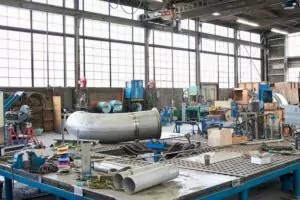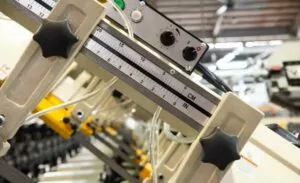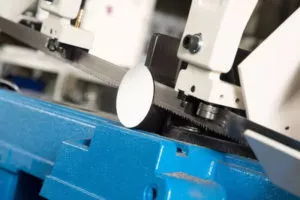Finding the right metal band saw for your workshop is a decision that directly impacts your cutting capabilities, productivity, and overall satisfaction. A metal band saw represents a significant investment in your shop, and choosing the wrong model can result in poor cuts, wasted materials, excessive blade consumption, and potentially expensive replacement costs.
At RongFu, we’ve manufactured premium metal band saw machines for over four decades as an OEM supplier to respected global brands. Our Band Saw Machine production experience has given us specialized knowledge about what makes a metal band saw perform effectively across different applications and user environments.
This comprehensive metal band saw selection guide breaks down everything you need to know—from evaluating your specific cutting requirements to understanding technical specifications and identifying the features that deliver the best value. Whether you’re a hobbyist establishing your first workshop or a business owner upgrading your metal cutting capabilities, we’ll help you select the perfect metal band saw for your specific needs and budget.
Assessing Your Metal Band Saw Requirements
Before comparing different metal band saw models or specifications, thoroughly assess your specific cutting requirements to narrow your options and prevent investing in a machine that won’t meet your needs.
Types of Materials You’ll Be Cutting
Different metals demand different bandsaw capabilities:
- Soft Metals (Aluminum, Brass, Copper): Cut easily but can gum up blades; benefit from good speed control
- Mild Steel: Requires moderate power and standard blade options
- Hardened Steels: Demand robust machines with excellent power delivery and rigid frames
- Stainless Steel: Benefits from precise speed control and rigid construction to prevent blade vibration
- Mixed Materials: Prioritize variable speed capabilities for optimized cutting
Frequency of Use Expectations
Be honest about how often you’ll use your bandsaw:
- Occasional Use (Monthly or Less): Entry-level models may suffice
- Regular Use (Weekly): Mid-range models with better build quality become important
- Daily Use: Professional-grade machines with robust construction become necessary
- Production Environment: Industrial models designed for continuous operation are essential
Space Constraints and Shop Layout
Consider your available space:
- Measure your available footprint, including operational space for material handling
- Consider ceiling height for vertical bandsaws
- Account for material infeed and outfeed areas
- Plan for maintenance access around the machine
Budget Parameters
Establish a realistic budget that accounts for:
- Initial machine purchase
- Essential accessories and tooling
- Delivery and installation costs
- Electrical modifications if needed
- Blade inventory for different materials
While entry-level hobbyist bandsaws start around $500, professional-grade machines typically range from $2,000 to $10,000+, with industrial models commanding significantly higher prices.
Hobbyist vs. Professional Metal Band Saw Models
Understanding the fundamental differences between hobbyist and professional-grade metal band saws helps identify which category best suits your needs and provides the best value for your specific metal cutting applications.
Key Differences Explained
Frame Construction Hobbyist models typically use lighter gauge steel frames adequate for occasional use but may develop alignment issues with heavy usage. Professional models feature heavier castings, often made from vibration-dampening cast iron, with precision-machined surfaces that maintain alignment under demanding conditions.
Motor and Drive Systems Entry-level bandsaws generally include 3/4 to 1 HP motors sufficient for lighter materials and intermittent cutting. Professional models incorporate 1.5 to 3+ HP motors with robust drive systems designed for continuous operation.
Precision and Durability While hobbyist machines can produce accurate cuts when properly set up, professional models maintain their precision over time thanks to more rigid construction, superior guide systems, and better blade tensioning mechanisms. They’re engineered to perform consistently during extended operation, while hobbyist models may struggle with heat buildup, vibration, and component wear.
Metal Band Saw Feature Comparison Table
| Metal Band Saw Feature | Hobbyist Models | Professional Models |
| Frame Construction | Lighter steel construction | Heavy cast iron or steel with reinforcement |
| Motor Size | 3/4 – 1 HP | 1.5 – 3+ HP |
| Blade Guides | Basic sealed bearings or guide blocks | Premium bearing guides with micro-adjustment |
| Speed Options | 2-4 fixed speeds or limited range | Variable speed or wider range of fixed speeds |
| Cutting Capacity | Typically up to 5″ round | 7″ and larger capacity |
| Coolant System | Basic or optional | Integrated with filtration |
| Warranty | 1-2 years limited | 2-5 years comprehensive |
| Price Range | $500-$2,000 | $2,000-$10,000+ |
Critical Metal Band Saw Specifications for Different Applications
The ideal metal band saw specifications vary significantly based on your working environment and typical metal cutting applications. Selecting the right specifications will ensure your metal band saw delivers optimal performance for your specific cutting needs.
Small Home Workshop Recommendations
For the home workshop with space constraints, limited electrical capacity, and intermittent use across diverse projects, prioritize:
- Compact footprint (typically horizontal bandsaw with vertical option)
- 3/4 to 1 HP motor compatible with standard residential power
- 4-5″ round cutting capacity for most hobbyist projects
- Mobility features for flexible shop arrangement
- Ease of blade changes for switching between materials
For more details on selecting the right machine for home use, see our guide on How to choose a band saw.
Small Business/Fabrication Shop Requirements
Commercial fabrication shops need machines that balance performance, versatility, and value:
- 1.5 to 2 HP motor for sufficient power across materials
- 7-9″ cutting capacity to handle common structural materials
- Variable speed capabilities for material flexibility
- Semi-automatic features for production efficiency
- Robust coolant systems for continuous operation
Industrial Production Environment Demands
Production environments prioritize throughput, reliability, and minimal downtime:
- 2+ HP motors with three-phase power
- Hydraulic control systems for consistent feed pressure
- Automatic material feeding capabilities
- Bundle cutting features for high-volume operations
- Advanced control systems with programmable cutting cycles
Metal Band Saw Size and Capacity Considerations
Understanding metal band saw size and capacity specifications helps ensure your machine can accommodate both current and future cutting projects. These specifications determine the maximum material dimensions your metal band saw can process effectively.
Understanding Cutting Capacity Specifications
Throat Depth refers to the distance from the blade to the frame, determining the maximum width of material you can cut.
Cutting Height specifies the maximum thickness or height of material the bandsaw can accommodate.
Cutting Capacities are typically specified in several ways:
- Round Stock Capacity: Maximum diameter of round material the saw can cut completely
- Rectangular Capacity: Width × height dimensions (e.g., 7″ × 12″)
- Angular Cutting Capacity: Maximum dimensions when cutting at various angles
For practical planning, reduce manufacturer specifications by 10-15% to account for real-world conditions and blade wear.
Space Requirements and Footprint Planning
When planning for your bandsaw, consider the complete operational footprint:
- Machine base dimensions
- Operational space for the operator
- Material handling zone for storage, infeed, and outfeed
- Maintenance access clearance
For horizontal bandsaws, plan for material infeed and outfeed areas equal to at least the length of your typical stock.
Metal Band Saw Power and Performance Factors
The power system is the heart of any metal band saw, determining what materials it can effectively cut and how quickly it can process them. Understanding these power-related specifications is essential for selecting a metal band saw that will perform optimally with your typical cutting materials.
Motor Size and Power Requirements
Bandsaw motors are typically rated in horsepower (HP), with higher ratings indicating more cutting power. However, the effective power delivery depends on several factors beyond the simple HP rating.
For cutting most mild steel in hobbyist applications, a quality 1 HP motor provides adequate power. Professional applications typically benefit from 1.5-2 HP motors, while production environments often require 2+ HP to maintain productivity under continuous operation.
Variable Speed vs. Fixed Speed Advantages
Variable speed capability dramatically enhances a bandsaw’s versatility by allowing operators to optimize cutting parameters for each specific material and thickness. These systems excel when cutting a variety of materials, as they allow matching the blade speed to the optimal feet per minute (FPM) range for each material.
Fixed speed systems typically offer 2-4 preset speeds selected by changing belt positions or through gearbox settings. While less convenient, these systems are often more economical and sufficiently versatile for shops that primarily cut similar materials.
When evaluating speed ranges, ensure the machine can operate at appropriate speeds for your materials:
| Material | Recommended Speed Range (FPM) |
| Tool Steel | 50-100 |
| Mild Steel | 100-200 |
| Stainless Steel | 70-120 |
| Aluminum | 200-350 |
| Brass/Bronze | 150-300 |
Single-Phase vs. Three-Phase Considerations
The power supply type significantly impacts both machine performance and installation requirements:
Single-Phase Power (typically 110V or 220V):
- Standard in residential and many small commercial settings
- Generally limited to motors of 3 HP or less
- Easier installation with standard electrical service
Three-Phase Power (typically 208V, 230V, or 460V):
- Common in industrial settings but rare in residential applications
- More efficient operation with less power consumption
- Smoother running with less vibration
- Required for larger motors (typically above 3 HP)
Metal Band Saw Features Worth Paying For
Not all metal band saw features deliver equal value. Understanding which options genuinely enhance cutting performance helps allocate your budget effectively when purchasing a new metal band saw.
Quick-Release Blade Tension Mechanisms
Quick-release mechanisms allow operators to instantly release and restore precise blade tension without losing the tension setting. This feature:
- Extends blade and wheel life
- Ensures consistent tension restoration for repeatable cuts
- Reduces setup time between operating sessions
- Facilitates faster blade changes
Coolant Systems and Their Importance
Effective coolant systems transform metal cutting operations by:
- Reducing heat generation to prevent material work hardening and blade annealing
- Providing crucial lubrication that reduces friction between the blade and material
- Improving surface finish quality and extending blade life
When cutting valuable materials or performing production work, an effective coolant system often pays for itself through blade savings alone.
Blade Guides and Their Impact on Cut Quality
The blade guide system provides critical support to the blade during cutting, directly influencing both cut accuracy and blade life:
- Ball Bearing Guides offer superior support with minimal friction
- Carbide Guide Blocks provide excellent wear resistance for heavy-duty applications
- Combination Systems with both back support bearings and carbide face guides offer the best performance
Superior guide systems maintain precise blade alignment even under load, resulting in straighter cuts, improved square, and extended blade life.
Budget-Friendly Metal Band Saw Options Without Sacrificing Quality
Strategic compromises can help balance budget constraints with metal band saw performance requirements, ensuring you get the best cutting capabilities for your investment.
Where You Can Compromise
Thoughtful compromises in selected areas allow quality where it matters most:
- Manual vs. Automated Features: Manual operations often achieve the same quality at lower cost
- Fixed vs. Variable Speed: If focusing primarily on one material type, multiple fixed speeds may suffice
- Integrated Stand vs. Separate Base: Consider mounting the bandsaw on a shop-built stand
- New vs. New Old Stock: Dealers occasionally offer unused machines from discontinued lines at reduced prices
Where You Should Never Cut Corners
Certain features directly impact performance and longevity:
- Frame Rigidity and Construction: Compromising on frame quality leads to alignment issues and poor cut results
- Motor Quality: Underpowered motors lead to stalling, overheating, and premature failure
- Blade Guides and Support System: Inadequate blade guides result in wandering cuts and excessive blade wear
- Warranty and Service Support: A comprehensive warranty provides crucial protection for your investment
Long-Term Cost Considerations
The initial price represents only part of the total ownership cost:
- Blade Consumption: Lower quality machines typically consume blades at 2-3 times the rate of premium models
- Energy Efficiency: Premium machines consume less electricity per cut
- Maintenance Requirements: Economy machines generally demand more frequent adjustment and component replacement
- Resale Value: Quality bandsaws typically retain 50-60% of their value after 5 years
When evaluating options, calculate the total five-year cost including these factors rather than focusing solely on the initial purchase price.
New vs. Used Metal Band Saw Considerations
The used metal band saw market offers potential value but requires careful evaluation to ensure you’re getting a reliable machine that will meet your cutting requirements.
When Buying Used Makes Financial Sense
Used industrial-grade machines built for decades of service often have considerable life remaining even after years of use. Used machines frequently sell for 40-60% of their new price, potentially allowing access to higher-grade equipment than would be affordable new within the same budget.
Inspection Checklist for Used Metal Band Saws
When examining a used metal band saw, systematically assess these critical elements to ensure the machine will perform reliably:
- Frame Condition: Check for cracks, repairs, damage, or excessive rust
- Wheel Condition: Examine for flat spots and check bearing condition
- Drive System: Inspect belt condition, gearbox, and motor operation
- Electrical System: Test all switches and inspect wiring
- Hydraulic System: Check for leaks and verify smooth operation
- Blade Guides: Check for excessive wear and proper adjustment
- Operational Test: Run the machine through all speeds and make test cuts if possible
Making Your Final Metal Band Saw Decision
Systematic evaluation helps identify the optimal metal band saw for your specific cutting needs, ensuring you invest in a machine that will serve your workshop efficiently.
Weighing Features Against Budget Constraints
Allocate your budget to maximize value in the areas most critical to your specific applications. Consider the cost-per-cut over the machine’s lifetime rather than focusing solely on the initial purchase price.
Considering Future Needs
Anticipate how your requirements might evolve over the next 3-5 years. While oversizing significantly beyond current needs wastes resources, choosing a machine with 25-30% more capacity than immediately required often represents good insurance against premature replacement.
After the Purchase: Metal Band Saw Setup and Optimization
Proper setup dramatically impacts metal band saw performance, cut quality, and machine longevity. Following these best practices ensures optimal results from your new metal band saw.
Initial Setup Best Practices
Follow these steps for optimal initial setup:
- Proper Leveling: Use machinist’s levels and adjust until perfectly level
- Electrical Connections: Verify proper voltage and circuit protection
- Initial Lubrication: Apply lubricant to all specified points
- Guide Alignment: Set blade guides precisely according to manufacturer specifications
- Test Cutting: Perform initial test cuts and make adjustments as needed
For detailed guidance on blade installation, refer to our guide: How To Install & Adjust A Metal Band Saw Blade.
Breaking in a New Metal Band Saw
Proper break-in procedures protect your metal band saw investment:
- Begin with light metal cutting for the first few hours, gradually increasing to normal loads
- Check all metal band saw adjustments, fasteners, and fluid levels frequently during initial use
- Operate your metal band saw at 70-80% of maximum capacity during the first 20 hours
Fine-Tuning for Optimal Performance
Beyond basic setup, these adjustments optimize performance:
- Experiment with blade tension within the manufacturer’s recommended range
- Determine optimal feed rates for your specific materials
- Adjust coolant concentration based on your specific cutting conditions
- Position guides as close to the workpiece as practical for each cut
If you encounter performance issues, our Troubleshooting Your Metal Band Saw guide offers solutions to common problems.
Essential Accessories
Enhance your bandsaw’s capabilities with these valuable accessories:
- Material Handling Supports: Proper infeed and outfeed supports prevent blade binding
- Premium Blade Selection: Invest in application-specific blades for optimal performance
- Measurement Tools: Precise measuring devices ensure accurate material positioning
- Safety Equipment: Personal protective equipment for safe operation
For guidance on selecting the right blades, see our article on How to Choose a Metal Cutting Bandsaw Blade.
Conclusion: Choosing the Perfect Metal Band Saw
Selecting the right metal band saw requires balancing your specific metal cutting needs against available options and budget constraints. By focusing on the critical factors outlined in this guide—material types, usage frequency, space constraints, power requirements, and essential features—you can make an informed metal band saw purchase decision that will serve your workshop efficiently for years to come.
At RongFu, we understand the importance of matching the right metal band saw to your specific requirements. As a manufacturer of both high-quality Band Saw Machine equipment and Mill Drill Machines, we’ve helped countless workshops find their ideal metalworking solutions through our precision-manufactured machines.
When selecting your metal band saw, remember to prioritize quality in the areas that most directly impact cutting performance—frame construction, motor power, and blade guide systems—while making strategic compromises in less critical areas if necessary. After purchase, proper metal band saw setup, break-in, and maintenance according to our Health & Safety Tips For Your Metal Band Saw will ensure optimal performance and machine longevity.
With the right metal band saw in your workshop, you’ll enjoy years of precise, efficient metal cutting capabilities that expand your project possibilities and enhance your productivity. A quality metal band saw is an investment that pays dividends through consistent cutting performance, reduced blade consumption, and the ability to tackle a wider range of metalworking projects.





